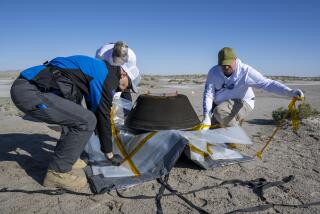Science / Medicine : Traces of Object That Hit Earth Found, UC Davis Scientists Say
- Share via
Two UC Davis scientists say they have discovered some shiny particles of pure platinum that are fragments of the six-mile wide object that many scientists believe slammed into the Earth 66 million years ago and shattered the reign of the dinosaurs.
In a paper to be published later this year, geochemist Stanley V. Margolis and graduate student Eric F. Doehne present the details of 2 1/2 years of painstaking microscopic analysis of ancient seabed sediments from Zumaya, Spain. They say they have identified particles that have the same chemical composition and structure as objects of extraterrestrial origin.
“We’ve identified the pieces of whatever struck,” Margolis said. The pieces: 12 platinum-filled grains and 50 magnesium ferrite spinels from 1/2 to 2 microns in diameter. (The width of a human hair ranges from 25 to 75 microns.)
Margolis and Doehne transported chunks of rock from the great seaside cliffs of Zumaya, where the iridium layer is thick, to their laboratory at UC Davis where they sliced the rocks into thin 1- by 2-inch pieces. They examined each slice with a scanning electron microscope, which provides high-magnification photos and some chemical details, and a microprobe, which provides a very detailed chemical analysis.
“We searched micron by micron. The platinum appeared like headlights,” said Margolis, who was also looking for fossils or anything else that would aid his detective work on this mysterious case of global catastrophe. After they found the platinum fragments in the four-inchiridium layer, they carefully inspected sediments above and below, but found no other fragments.
But scientists are confused by the purity of the platinum grains. “I can’t explain it,” said Frank Kyte, a geochemist at UCLA. “But I’d be surprised if they’re fragments of a meteorite. My best guess is that they condensed out of the vapor cloud of the impact.”
Edward Anders, professor of chemistry at the University of Chicago and a recognized leader in cosmogeology, does not dismiss the UC Davis scientists’ find so easily. “Nature is trying to tell us something,” he said. “And it’s up to us to figure it out.”
And writing in the British journal Nature last week, Meixun Zhao and Jeffery Bada of the Scripps Institution of Oceanography reported they found two amino acids in sedimentary rock at Stevns Klint, Denmark, that also provide strong evidence that dinosaurs were wiped out by a meteorite.






